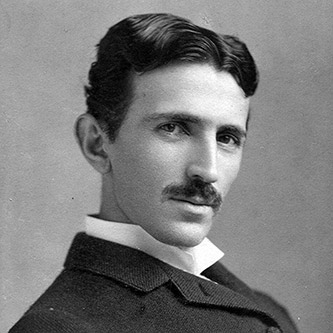Nichola Tesla Collection
Tags | |
UUID | 1bd5a3ba-f145-11e9-8682-bc764e2038f2 |
Who Was Nichola Tesla
Nikola Tesla was one of the great scientist inventors of the late 1800s and early 1900s. In today's world Tesla would have been tagged as an electrical engineer for his primary contributions to the science of electromagnetic theory. But he also created and engineered devices and systems that would better fit in the realm of mechanical engineering.
Above all Tesla was a physicist, with a keen intellectual grasp of many fundamental principles of the world around him.
Tesla became a naturalized US citizen in 1891 and lived the remainder of his life in the US.
Tesla Legacy and Best Known Contributions
Alternating Current
Tesla is most famous for his contributions to the science and design of the alternating current (AC) . Today power is transmitted everywhere by systems evolved directly from his research. Though there was much controversy in the assignment of who invented a number of key modern technologies, not the least of which was AC power, It is pretty clear from historical record that Tesla invented the AC power generation system.
Tesla worked for Thomas Edison and later his AC system would overtake Thomas Edison's direct current (DC) power generation systems. He patented the AC induction motor and transformer, which were licensed by George Westinghouse and contributed directly to the emergence of the Westinghouse empire.
This same phenomena powers our world today as suggested by "Electricity is one of our most faithful servants ..." Listen to a Veritasium music video about electricity and ask the question: "What is electricity".
The Tesla Unit
Tesla was recognized for his scientific contributions when the SI unit of Magnetic Flux Density was named for him. The General Conference on Weights and Measures conferred this great honor on Tesla in 1960. There is a vCalc equation that will let you convert between various units of magnetic flux density: <<select here>>
Wireless Communications
made early (1893) pronouncements on the possibility of wireless communication with his devices. He tried to put these ideas to practical use in an ill-fated attempt at intercontinental wireless transmission, his unfinished Wardenclyffe Tower project.
Locations of Tesla's Key Laboratories
Wardenclyffe
Tesla went on to pursue his ideas of wireless lighting and electricity distribution in his high-voltage, high-frequency power experiments in New York and Colorado Springs and made early (1893) pronouncements on the possibility of wireless communication with his devices. He tried to put these ideas to practical use in an ill-fated attempt at intercontinental wireless transmission, his unfinished Wardenclyffe Tower project.[9] In his lab, he also conducted a range of experiments with mechanical oscillators/generators, electrical discharge tubes, and early X-ray imaging. He also built a wireless controlled boat, one of the first ever exhibited.
Colorado Springs: The Lost Laboratory
There are a couple of interesting analyses that define a location of the laboratory Nicholas Tesla built in Colorado Springs. The first is an video presentation cited below that was created by the Pikes Peak Library District (PPLD) called:Tracing Tesla: the Search for His Lost Laboratory. The second analysis comes up with a very interesting and probably accurate prediction of the location of the Tesla's Colorado Lab Location. The author, Bill Welker, computes a very precise location as: 38.834177 deg N lat, 104.800065 deg W lon, at the southeast corner of what is today the intersection of Kiowa and Foote.
Biographical References
Video Documentary: Tracing Tesla: the Search for His Lost Laboratory
One of the most interesting videos produced by the Pike Peak Library District documents Tesla's time in Colorado Springs and pursues the question of the exact location of Tesla's research lab in Colorado Springs. Here is the link to the video: Tracing Tesla: the Search for His Lost Laboratory
Then and Now Investigation: Tesla's Colorado Lab Location
The Tesla Universe: website by Cameron B. Prince
Ripley's Believe It Or Not: Nichola Tesla Video
This Collection is empty
- Comments
- Attachments
- Stats
No comments |

